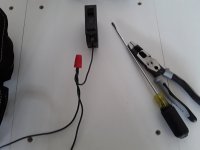I asked an electrician friend once about twisting wires before putting on the wirenut. He said it wasn't required--but if you didn't do it on the job, that'd be the end of your job (I think he was union, at least for a while).
Backstab outlets I do believe are UL listed, yet they are not very well liked by anyone.
So it's a legit question. Just because something meets spec doesn't mean it's good (nor liked). Me, once someone pointed out Wago's to me, I looked it up, and found that wirenuts aren't allowed in (UK and maybe Europe), but these are. I thought about it and decided I'd run with them.
Backstab outlets I do believe are UL listed, yet they are not very well liked by anyone.
So it's a legit question. Just because something meets spec doesn't mean it's good (nor liked). Me, once someone pointed out Wago's to me, I looked it up, and found that wirenuts aren't allowed in (UK and maybe Europe), but these are. I thought about it and decided I'd run with them.

![[Linked Image] [Linked Image]](https://www.bobistheoilguy.com/forums/attachments/usergals/2020/01/full-32841-40665-83175957_489277168669147_2130794994225643520_n.jpg)
![[Linked Image] [Linked Image]](https://www.bobistheoilguy.com/forums/attachments/usergals/2020/01/full-32841-40666-83205221_1097597150585366_6690749231084339200_n.jpg)
![[Linked Image] [Linked Image]](https://www.bobistheoilguy.com/forums/attachments/usergals/2020/01/full-32841-40667-83363473_474734126549910_1162358630087917568_n.jpg)
![[Linked Image] [Linked Image]](https://www.bobistheoilguy.com/forums/attachments/usergals/2020/01/full-32841-40668-83308424_487525688625106_533660651579506688_n.jpg)
